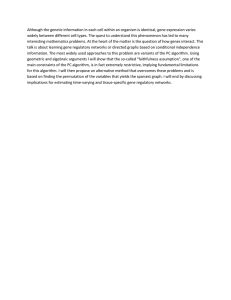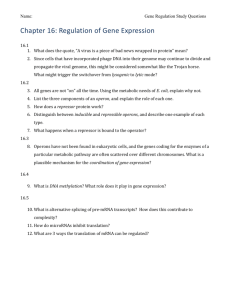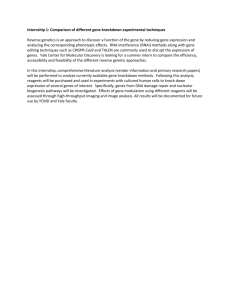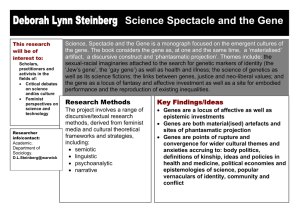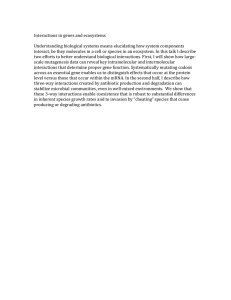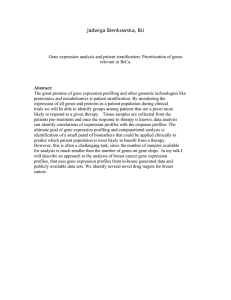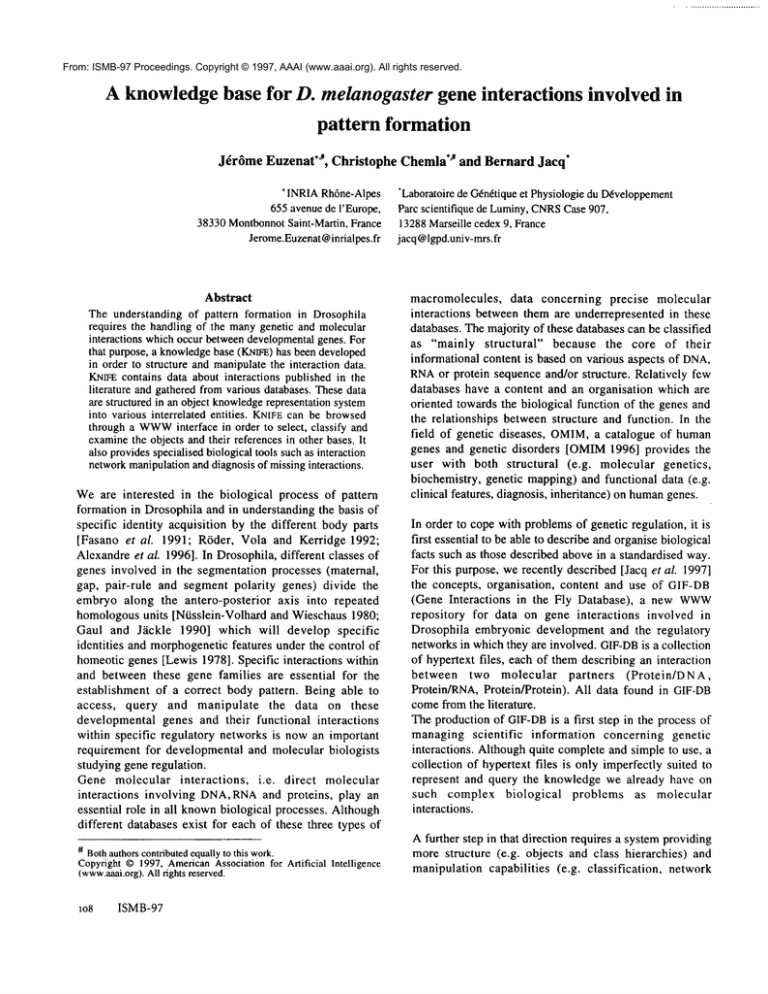
From: ISMB-97 Proceedings. Copyright © 1997, AAAI (www.aaai.org). All rights reserved.
A knowledge base for D. melanogaster gene interactions involved in
pattern formation
J~rSme Euzenat+’*, Christophe Chemla"’# and Bernard Jacq"
÷ INRIARhrne-Alpes
655avenuede I’Europe,
38330Montbonnot
Saint-Martin, France
Jerome.Euzenat
@inrialpes.fr
Abstract
The understanding of pattern formation in Drosophila
requires the handling of the manygenetic and molecular
interactions whichoccur betweendevelopmentalgenes. For
that purpose,a knowledge
base (KNIFE)
has beendeveloped
in order to structure and manipulatethe interaction data.
KNIFE
contains data about interactions published in the
literature and gatheredfromvarious databases.Thesedata
are structured in an object knowledge
representationsystem
into various interrelated entities. KNIFE
can be browsed
through a WWW
interface in order to select, classify and
examinethe objects and their referencesin other bases. It
also providesspecialisedbiologicaltools suchas interaction
networkmanipulationanddiagnosisof missinginteractions.
Weare interested in the biological process of pattern
formation in Drosophila and in understanding the basis of
specific identity acquisition by the different body parts
[Fasano et al. 1991; Rrder, Vola and Kerridge 1992;
Alexandreet al. 1996]. In Drosophila, different classes of
genes involved in the segmentation processes (maternal,
gap, pair-rule and segment polarity genes) divide the
embryo along the antero-posterior axis into repeated
homologousunits [Niisslein-Volhard and Wieschaus1980;
Gaul and J~ickle 1990] which will develop specific
identities and morphogeneticfeatures under the control of
homeotic genes [Lewis 1978]. Specific interactions within
and between these gene families are essential for the
establishment of a correct body pattern. Being able to
access, query and manipulate the data on these
developmental genes and their functional interactions
within specific regulatory networks is nowan important
requirement for developmental and molecular biologists
studying gene regulation.
Gene molecular interactions,
i.e. direct molecular
interactions involving DNA,RNA
and proteins, play an
essential role in all knownbiological processes. Although
different databases exist for each of these three types of
# Both authors contributed equally to this work.
Copyright © 1997, American Association for Artificial
(www.aaai.org).All rights reserved.
~o8
ISMB-97
Intelligence
’Laboratoirede G~nrtiqueet Physiologiedu l~veloppement
Parc scientifique de Luminy,CNRS
Case907,
13288Marseillecedex9, France
jacq @Igpd.univ-mrs.
fr
macromolecules, data concerning precise molecular
interactions between them are underrepresented in these
databases. Themajority of these databases can be classified
as "mainly structural"
because the core of their
informational content is based on various aspects of DNA,
RNAor protein sequence and/or structure. Relatively few
databases have a content and an organisation which are
oriented towards the biological function of the genes and
the relationships between structure and function. In the
field of genetic diseases, OMIM,a catalogue of human
genes and genetic disorders [OMIM1996] provides the
user with both structural (e.g. molecular genetics,
biochemistry, genetic mapping) and functional data (e.g.
clinical features, diagnosis, inheritance) on humangenes.
In order to cope with problemsof genetic regulation, it is
first essential to be able to describe and organise biological
facts such as those described above in a standardised way.
For this purpose, we recently described [Jacq et al. 1997]
the concepts, organisation, content and use of GIF-DB
(Gene Interactions in the Fly Database), a new WWW
repository for data on gene interactions involved in
Drosophila embryonic development and the regulatory
networksin whichthey are involved. GIF-DB
is a collection
of hypertext files, each of them describing an interaction
between two molecular partners
(Protein/DNA,
Protein/RNA, Protein/Protein). All data found in GIF-DB
comefrom the literature.
The production of GIF-DB
is a first step in the process of
managing scientific
information concerning genetic
interactions. Althoughquite complete and simple to use, a
collection of hypertext files is only imperfectly suited to
represent and query the knowledge we already have on
such complex biological
problems as molecular
interactions.
Afurther step in that direction requires a systemproviding
more structure (e.g. objects and class hierarchies) and
manipulation capabilities (e.g. classification, network
traversing) than a relational database or a flat WWW
server.
Suchan organisation will provide the opportunity to gather
interactions into networks and to compare, check and
simulate these networks.
The KNIFE system (Knowledge on Networks of
l , which is presented here,
Interactions in the Fly Embryo)
is a knowledge base putting together data and methods
about interactions gathered in other databases. It has been
developed using the TROPESknowledge representation
system, is directly accessible from the WWW
and provides
several specific utilities such as networktraversing and
analysis.
The choice of an object-based knowledgerepresentation
system has already been madeby several teams working on
metabolism [Karp and Mavrovouniotis 1994] or genetic
regulation [Perri~re et al. 1993; Hoogland and Bi4mont
1997]. The more closely related work to this one is the
work around the EcoCYCknowledge base on Escherichia
coli genes and metabolism [Karp et al. 1996]. It is an
example of a knowledgebase which integrates functional
aspects since one can find both data on gene structure and
their function in the regulation of biochemical pathways.
Although it focuses on metabolism instead of genetic
regulation, there are several features commonwith the
work presented here: use of knowledgebase technology;
availability through WWW,
including for graph drawing;
developmentof specific algorithms for using the networks
(pathways). An important difference is that the context
whichgenetic interactions are valid is not well knownyet.
The TROPES
object-based knowledgerepresentation system
is first described. Then, the objects, modellingKNIFE
data,
are presented at length. The functions offered by KNIFE
are
exposed in the remainder: first the general functions
available in TROPES(WWWbrowsing, classification,
filtering) are presented; then, specific methodstied to the
exploration of genetic interactions (graph traversing and
diagnosis of missing interactions) are detailled. The
discussion focuses on a long term goal: the simulation of
interaction networks.
Short presentation
of TROPES
TROPES
is an object-based representation system which
favours classification. It is here presented throughits basic
notions, while more specific descriptions will be found in
the remaining sections.
Objects and concepts
In TROPES
[Marifio et al. 1990; Sherpa 1995] individuals
are represented as objects. The objects are partitioned into
concepts (an object is an instance of one and only one
concept). As an example, the protein
concept concerns all
the individual proteins. Ontological prerogatives are
attached to the concept. They warrant the integrity of an
object (i.e. that the object cannot be modified in a way
which would lead it to no longer be an instance of the
concept) and its identity (i.e. it can always be uniquely
identified). Theseprerogatives play an important role when
the object is created and registered.
The conceptalso defines the structure of its instances. The
structure of an object is uniquely determined by a set of
fields and their basic domainsindependently of the classes
to which the object can be attached. For example, the
instances of the protein concept have a name, a size and
a sequence field. The basic domainof a field is either a
primitive type (string for the name,integer for the size),
concept (protein-sequence
for sequence) or a type
constructed from primitive types and concepts with the
help of set and list constructors.
The field values are part of the objects and do not depend
uponthe classes to which the objects are attached. For
instance, the protein B!COID
is represented by an object
instance of the protein class. Its namefield has the string
~BICO’rD"
for value, its size field has integer 494for value
and its sequence field has the instance of the proteinsequenceconcept also namedB’rco’rD for value.
Viewpoints
Objects can be seen under several viewpoints, For instance,
BICOID is classified
as a transcription-factorunder
the biochemical-function viewpoint and as a nuclei
protein under the initialand final-sub-cellularlocation. The viewpoints allow to restrict the view on
instances and to organise the concept into particular
taxonomies. A viewpoint determines:
¯ The set of fields whichare relevant under the viewpoint
(the sequence
is not relevant from the sub-cellularlocation viewpoints as well as the size under the
biochemical-function one, and thus the
corresponding fields are hidden under the respective
viewpoints).
¯ A hierarchy of classes under whichthe instances of the
concept can be classified. Eachviewpoint offers to the
user a new taxonomyunder which the classification
operation dependson different criteria. Theyallow to
focus on particular aspects of objects without being
disturbed by others. Classes are related through the
specialisation relation and determine progressive
subsets of the set of instances of the concept. Underthe
biochemical-function viewpoint,
proteins are
divided into enzymes, DNA-associated, growthfactor, and other classes; DNA-associated can be
1 http : //www-biol.
univ-mrs, fr/-igpd/knife.html
Euzenat
..................................................
.....................................................................-.-
1o9
..-.....-.-....-.-.-.-.--.-.-.- - ¯ -.-. ....................................................................................................................................................................................................................
Viewpoint-
l
ize
~~A.
Concep[,,~ protein
initial
~k -sub-cellular
\-lOcatiOn
I
I pr°tein
biochemical
b~ -function
I ~
L--~
~- .~ " "~_" ]: - ~ "~ - ~.:" " "[ " - ~ protein
protein
I I II I -celIula~IA
I
~ ~ ]
large~ II I -matrix
V I~I 1 DNA
" l~ I
v %.| I
,/
I | | -associatedD~’
average ~ ~ I
I /~ 0 growth-factor
I ~ ~ %1
I,//\
Is~[1u I plasmic-r~l I|
I k I
I 0 |/chromatin U I 1%
. .
I
\ I cytoplasmic %/-compaction/ ~kt~ac~SCnpt~°n
I
~ I
|
0
~Ob<ect~
I
_factor
]nuclear
/
l~la
for
/~
BICOID
Figure I. The protein concept is visible under the size, initial-sub-cellular-locationand biochemicalfunctionviewpoints.
Eachof themdetermines
a hierarchy
of classeswhoseroot classis namedprotein.
For instance,
under
the biochemical-function
viewpointthere is a decomposition
of the set of proteinsfollowingtheir functions.The
B I CO I D objectis attached
to the averageclassunderthes i z e viewpoint,
to the nuc i ear classunderthe initial-subcellular-location
viewpointand to the DNA-associatedclass under the biochemical-function
viewpoint
¯ vided into transcription- factor and chromatincompaction- factor.
Classes
and taxonomy
A class defines constraints that objects must satisfy in
order to belong to the class. It is a projection of the
structure of the conceptretaining only relevant fields and a
restriction of the possible values of these fields. This is
achieved with the help of:
¯ Primitive domain restriction
provided by domain
enumeration, exclusion or bounding (the effect field
of an interaction has a string value enumerated by
"activation", "repression" and ~activation-andrepression"; the size of an average protein can be
between3 0 0 and 10 0 0 an]ino-acids).
¯ Attachmentrestrictions for concepts: the field values
must not only be instances of a particular concept but
can be constrainedto belongto particular classes of that
concept (the value of the sequence field of a protein
must be memberof the protein-sequence class).
¯ Constraints on field values. These constraints are
membershipconstraints or constraints between fields
(the s i z e of a RNAcannot exceed that of its DNAsequence).
¯ Cardinality restriction on sets (rasp. lists) by bounding
their numberof elements.
Anobject is attached to (to be opposedto "is memberof")
only one more specific sub-class under a viewpoint, but is
memberof all the classes of which this class is a
specialisation. The interpretation of the spccialisation
relation is twofold: first, the membersof a class are
uo
ISMB-97
members of its super-classes
(extension inclusion
property); second, the constraints defined in a class apply
to all the membersof that class (and thus to the objects
attached to all of the more specific classes). In the above
example,it meansthat:
¯ alltranscription-factorSare DNA-associateciand
¯ all transcription-factors, as DNA-associated,
inherit their constraints (e.g. being located in the
nucleus).
So the strengthening of the constraints from class to subclasses is parallel to the restriction of the extension. As
opposedto instanciation, objects can be attached to a class
and can be detached from it at anytime. Classes also allow
the expression of hypothetical knowledge in terms of
default values or default inference methods.
TROPES has
other features which are not relevant here.
Some of them will be presented when needed in the
remainingsections.
Biological knowledgerepresentation
The core of the systemis described hereafter. It is madeof
a repository (expressed in TROPES)
of concepts, classes and
instances representing biological entities. The data
originates from other standard repositories and GIF-DB.
Figures given here are those at the date of DecemberI st,
1996.
General overview
The knowledge base, while still
incomplete, has been
carefully designed in order to reflect the complexity of
gene interaction. The KNIFEbase contains 16 concepts
related with manydifferent aspects of interactions. Figure
2 presents these concepts and the relationships between
them through fields referring to each others. The main
concepts, with regard to the present paper, are network.
interaction, expression, gene and protein. Theywill
be detailed in depth below.
The other concepts, although being useful to the biologist
looking for where, howand whyan interaction can happen,
are not yet used by the automatic facilities of KNIFEThey
can be briefly described in the following manner(numbers
in parentheses indicate the number of instances in the
actual knowledgebase):
mutant (0): the mutant concept describes the kind of
mutations which can be applied to a gene and the
resulting phenotype.It is not presently used.
binding- site- feature (43): describes the binding-sites
involved in the interaction betweenbiological objects.
They refer the actual sequence through their sequence
field and the binding protein through the
overlaps-
with-proteinfield.
precursor-rna(27):
The precursors of a gene are the
RNAproducts which have not been spliced. It was
necessary to introduce precursors because the same
precursor can be spliced differently or two different
precursors can give rise to the same product after
splicing.
rna(29): rnaobjects record the information concerning
RNA.Anobvious one is the sequence field referring to
the rna-sequenceitself, the product field referring to
the protein expressed by the RNAstrand. The
expression field is meantto describe in which context
this particular RNA
strand is to be expressed. Theserna
objects are referred to by the gene concept, allowing
them to determine their corresponding expression
patterns.
dna-sequence (51), rna-sequence (4), proteinsequence (25): the individual sequences of DNAare
described
by subsequences (called
dna-part)and
--> dependency
> single-valued field
~,- set-valued field
maintained
automatically
inding-sites
binding-site-feature
target-rna
precursor
--.gene
sequence expression
product
expression
[ expression
pans
signals
rna-sequenc~]
signals
I protein-sequencel
/
features]
[dna-sequence-part-feature~{dna-signal-feature
I rna-sequence-part-featur~lrna-signal-featur
~ I protein-feature~
Figure 2. KNIFE
conceptsand their dependencies.Boxesrepresent conceptswhile labelled arrowsrepresent object
fields.
Euzenat
111
signals detected in the sequences (dna-signal);these
fields contain objects knownas dna-sequence-partfeature and dna-s ignal-feature. Tile same applies
withslight
variations
to rna-sequence
andproteinsequence
(with no signal/part distinction).
They
originate from the international sequence databases
(EMBL[Rice et al. 1993] and SWlSSPROT
[Bairoch and
Apweiler 1996]).
dna- signal- feature(2),rna- s igna i - lea ture (4):
describes the various signals (binding sites for
regulation proteins, splicing sites) that can be found in
the regulatory region of a gene or precursor.
dna-sequence-part-feature
(2), rna-sequencepart-feature
(4): describe the functional parts that
can be found in a gene. For RNA
these are just the parts
corresponding to that of DNA.
protein-feature
(152): the various structural and
functional features (zinc-finger, leucine-zipper,
homeodomain
and helix) of a protein.
Interactions, proteins and genes
The main concept in KNIFEis the interaction
concept
containing currently interactions between proteins and
genes (type I). Each interaction connects an effector
(which is a protein, instance of the protein concept) to
target (which is a gene, instance of the gene concept). In
addition, the interaction has a effect field whichcontains
a string qualifying the interaction effect as "activation’,
"repression" or both. The interactions also mention the
followingfields:
binding-s i tes: refers to the set of binding sites (concept
binding-site-feature) involved in the regulation;
structure-of-target-product,
structure-of-
effector:
refers by a string to the knownstructural
patterns in the products (e.g. zinc-fingers,
homeodomains);
dose-dependence:indicates if the interaction dependson
the concentration of the effector. This is not currently
used by the algorithmsbut will be useful in the future;
protein-partners: contains a set of proteins which
are also involvedin the regulation;
other fields contain information from the literature among
which the experimental methodsused for pointing out
the interaction or the regions of the embryowherethere
is evidencefor the interaction [Jacq et aL 1997].
Protein-RNAand protein-protein interactions can also be
represented. All these interactions are viewed through
viewpoints depending on their types (whether they imply
protein, RNA
or DNA
target), the structure of effectors and
target product, the effect of the interaction and the classes
of the involved products (classified after [Pankratz and
Jiickle 1993] for gap genes). The interactions in the base
comefrom GIF-DB[Jacq et al. 1997].
ISMB-97
The two main elements involved in interactions
are
proteins and genes. Figure 1 displays three viewpoints on
the protein concept which has been largely described
above. This concept introduces views depending on the
initial and final locations of a protein involved, for
instance, in the signal transduction pathways; the
biochemical-function view considers the families of
protein biochemicalfunctions.
The gene concept refers to the sequence of the gene, the
precursor RNAand the protein it codes for through the
corresponding fields. It can be viewed under four
viewpoints: its cytological-location,
its phenotypic
class, its number of precursors and the size of its
transcription unit. This is an importantissue since the time
required by the R N A-polymerase to transcript D NA
dependson the size of the unit. This can thus be used in
order to impose temporal constraints to the models of
embryogenesis(for somehomeotic genes, the transcription
can last morethan one hour).
At start up, KNIFEcomputesthe reverse links from genes
and proteins. It is then possible to refer to interactions
regulating the gene (incoming)and to interactions in which
the geneproduct is regulator (outgoing).
Genes and proteins originate mainly from FLYBASE
[Flybase 1996] and SWlSSPROT
[Bairoch and Apweiler
1996] and their representation obey the FLYBASE
control
vocabulary. At the moment,there are 25 genes, 26 proteins
and 62 interactions.
Expression patterns
concept provides, for a particular
developmentstage and a particular mutation (or wild type
individual), the Iocalisation of the expression of a gene,
protein or a particular RNA.Expression patterns are thus
identifiable throughthe followingfields :
developmental-stage is a string which denotes the
stage at whichthe expressionis found;
gene-namecontains the name of the corresponding gene
object;
genetic-context
is a string denoting the kind of
mutation(or "WT"for wild type).
It provides a set of segments of the embryoin which the
product of the gene is found. These patterns are encodedin
various ways. The main one is the egg-length-domain
field which contains the boundsof the intervals of the egg
(expressed in percentage of the length of the embryo)
wherethe product is found. For instance, the expression of
the fushitarazu
gene at the cellular blastoderm stage for
a wild individual is madeof 7 stripes (shownon Figure 3):
11-16, 20-24, 28-32, 36-40, 44-48, 52-56 and 60-63%of
the egg length. The egg-length-domain
is not the only
field containing this information: it is encodedin other
common formats
(regions,
segments
and
The expression
Figure 3. Theexpressionpatterns of the expres s i on conceptare displayedby a Java applet. This allows the users to quickly
identifythe patternson the fly egg.
parasegments).
This information can be found in the two main views
which are offered to the user and which decomposesthe
expression with regard to the expression-regior~ (the
place of expression:
thorax, abdomen, terminalanterior,
etc.)andtheexpression-domains
(thepatter.
ofexpression:
s tripe,
gradient,
etc.).
To date, there are 46 expression patterns comingfrom the
DEXIFLY
database [Horn et aL, submitted].
Interaction networks
In the KNIFE
sense, a networkis nothing more than a set of
interactions. Its interactions field contains the set of
interaction objects involved in the network. It is
identified by a name. Ideally the networks should be bound
to a context expressedthrougha set of fields:
type is the genetic context of the embryo(wild type or
mutantfor a particular gene);
development-s
tagespeaks for itself;
beginning and end arethe be~nning
and endof egglength wherethe networkis supposedto occur.
The use of the exceptions field, containing a subset of the
interactions,
is described below. There is no network
stored as such in the base: building a meaningful network
is the goal of manipulatingthe data.
KNn~access
An important benefit from the modelling of the knowledge
in TROPES
is the possibility to automatically obtain a web
server, allowing, without any effort from the developer, to
manipulate the base. This is the subject of that section
while the next one concentrates on the specific algorithms
developedfor KNIFE
and integrated in the website.
Webavailability
TROeF_.~can be transformed into a HTTPserver [Euzenat
1996], which means that the knowledge base is
automatically turned into a Website. Each TROPES
entity
(e.g. object, concept, concept field or class) is provided
with an URLand a display function which generates a
HTML
page (which may contain references to the other
entities through their own URL). Whensuch a page is
displayed by a HTI’Pclient (or browser), if the user selects
Euzenat
113
Figure4. Anetwork.Thelist of fields is displayedabovea graphicrepresentationof the network.Normal
arrows(-->) indicate
activatinginteraction, T-ending
arrows(--I) andinhibitinginteractionandothers (-->1)a twofoldinteraction. Thegraphapplet can
manipulated
by the usersso that the displaysuits their needs.
a particular hypertext link in the page, this will fetch the
page corresponding to the embeddedURLand this page
will be loaded in the client. Each page is generated on
demandfrom the object in the base.
This capability alone has several advantages since it
generates a site free of dangling links and allows the
remote access to the knowledge base without special
training or special computer model. But other, more
elaborate, advantages comewith someadditional work.
First, it is possible to provide annotations to TROPES
entities. These annotations can be HTML
files which will
be incorporated in the usual page generated by TROPES
in
order to documentthe displayed object. This provides a
first level of enrichment of the Webpages. The included
page can be arbitrarily
complex (containing U RL or
images).
Moreover,if the default display pattern of the pages is not
suited to the current task, it is possibleto redefineit. Figure
3 and Figure 4 showsuch redefinition with the call, during
the generation of the page, to a specialised applet (a
~14
ISMB-97
program which is run in the H’I’FP browser) which draws
graphic pictures of the considered entity. An important
aspect of this is the possibility to automatically generate a
call to an applet with the correspondingdata. This function
also offers the opportunity to generate automatically forms
that will send a specific query to an independentdatabase
without the burdenfor the user to construct the query. This
is used in KNIFEfor providing access to the remote
resources familiar to the user community(FLYBASE for
genetics, EMBLand SWlSSPROT
for gene and protein
sequences and GIF-DB
for interactions).
Queries
From a knowledge base described according to the
presentation above, it is possible to apply operations
provided by the knowledgerepresentation system. So far,
TROPES
provides two main operations: classification and
filtering. Classification consists, for a particular object, in
identifying the classes to whichit can be attached; filtering
consists, froma particular class, in identifying the objects
which could be attached to it. For their respective
Figure5. Afiltering: the result of filtering the proteinsof averagesize whosebiochemicalfunctionis a transcriptionfactor is:
DECAPENTAPLEGIC,
SEX COMBS
REDUCED,WINGLESS,TAILLESS, RUNT,DORSAL
and BICOID.
purposes, these operations comparethe values in the object
fields (whateverthey are: string, number,objects...)to the
constraints attached to the class fields.
TROPES
allows to use these reasoning mechanismsin order
to issue queries against the base through the Web. For
example, filters are used for selecting objects which are
attached to certain classes and contain particular field
values. These filters are accessible through the HTrPserver
and allow a moresophisticated search than full text search.
For instance, it is possible to ask for all the instances of
protein, which are classified
as averagein sizeand
whose biochemical-function
is transcriptionfactor. The result is provided in Figure 5.
Network manipulation
The manipulation features described so far are provided in
a standard way by TROPES.No particular programmingis
required, but the knowledgebase description. In order to
go further somealgorithms have been developed specially
for the needs of KNIFE.They consist in a graph traversal
algorithm and an algorithm for diagnosis of missing
interactions.
Networkcreation and traversing
The KNIFEknowledge base page contains a panel with
several operations which apply to the whole base and are
specific to the application. First several buttons allow the
interactive creation of new networks through the direct
selection of the involved interactions or the selection of
products which must be source or/and target of the
interactions. This allows to create and store sub-networks
of particular interest (e.g. the gap-genenetwork).
KNIFEalso allows the enumeration of the paths in a
networkbetweena particular product and a particular gene
(selected interactively). For instance, there are 51 possible
ways for the BICOIDprotein to regulate the hunchback
gene from the interactions stored in the base (Figure 6).
The implemented algorithm is a classical three-passes
traversal which proceeds in O(INI) where N is the set
nodes in the graph (protein
objets). It is generally faster
than the time required for displaying the result.
Euzenat
115
Figure6. Graphtraversing providesall the paths of length less than or equal to 7 betweenthe BICOID
protein and the hunchback
gene.
Diagnosis of missing interactions
The diagnosis of missing interactions is a new algorithm
whichcould be invaluable for building networks. Its aim is
the detection of interactions which should have activated
(resp. inhibited) the expression of a gene while this
expression is not (resp. is) observed. For that purpose, the
user selects the type of fly (e.g. wild type or mutant) and
the developmentalstage considered (syncitial or cellular
blastoderm in the current state of the base). It is also
possible to select a particular area (expressed by a segment
of the egg) of the fly. The algorithm will then fetch the
expression of all the knowngenes at that stage for that
individual and construct a division of the embryobased on
all the patterns. For instance, if we consider the genes
Deformed,runt, fushi tarazu,Antennapediaand
even-skipped, whose expression patterns (for the wild
animalat cellular blastoderrn stage) are shownin Figure 7,
the result is:
0-9-11-16-17-20-24-25-28-32-33-36-40-41-44-45-48-4952-56-57-60-63-64-65-68-75-100
n6
ISMB-97
Then, the system will build a network for each interval
obtained and each network will contain the interactions
whose source is a product expressed in the concerned
region. For instance, and for the interaction contained in
the KNIFEbase, the interactions involved between48%and
49%of the egg length are (--> meansactivation, --I means
repression):
GF2i: even-skipped
-->even-skipped
0
10
20 30
40
50 60
I
70 80 90 100
I
F
’i’ili~2iii:.~ii!ii:ii~
i
Deform’ed
runt
,N
fushi tarazu
I ’
I
n
Antennapedia
~.,.:.::-.:
¯f-:.:.::a I
~
L
’
,I
...
I
I
i
even-skipped
I
4849%
Figure7. Expressionpatterns andthe consideredinterval between
48 and 49%of the egglength.
GF22: even-skipped--] fushi tarazu
GF64: Antennapedia --[ Sex combs reduced
GF20" even-skipped --> engrailed
GF63: Antennapedia--> Sex combs reduced
GF59: even-skipped--> Deformed
GF40: runt --I even-skipped
Afterward, for each network, the system will point out the
products which are expressed although they are inhibited
by an active interaction (and activated by no active
interaction) or those whichare not expressed although they
are activated by an active interaction (and inhibited by no
active interactions). In the formerexample,the interactions
GF20 and GF59are in such a case. For instance, GF20tells
that if even-skipped is present, it will activate the
expression of engrailed, but engrailed is not present
and no other product seems to inhibit it. This meansthat
the base is incomplete on that interaction:
either
engrailed is expressed (and so its expression pattern is
wrong)or somethingrepresses its expression.
On another hand, there are no exception on Sex combs
reduced which is activated by Antennapedia because
there is another repression interaction (from Antennapedia
tOOin that case).
These interactions are put in the exceptions field of the
network. This only meansthat the content of the base does
not explain the observations. This is an invitation for the
researcher to add new knowledgeabout interactions in the
systemor to plan an experimentin order to gather evidence
for this lack of knowledge.
If there exists a bound to the number of intervals in a
2)
pattern, the complexityof the algorithm is in O(INI*IAI
whereAis the set of interactions. Thereare several waysin
which this algorithm could be improved: by targeting the
diagnosis on a particular gene or a particular network.
Discussion
The KNIFEknowledge base described above presents
several noticeable features:
¯ the data is type-checked(detection of type-mismatchor
misspelling for instance);
¯ it can be browsedand madeavailable in a client-server
fashion (and this is due to the use of a formal
representation language);
¯ it allows the linking of these data with other knowledge
sources (other bases, raw data or bibliographic data)
while offering its ownperspective on the data;
¯ it provides efficient ways of manipulating the data
throughfilters or classification;
¯ it allows the usage of specialised algorithms whichtake
their input in the base and deliver their output to the
base.
Froma biological point of view, it has to be noted that
KNIFEis the first knowledgebase which is devoted to the
description of gene interactions and their networks. Upto
now, the amountof biological data present in the base is
not yet sufficient to get completelysignificant results with
the algorithms. This conclusion is in fact the result of the
use of the algorithms themselves, since they are able to
detect inconsistencies in the data. Anotherproblemis that
the missing interactions algorithm is too simplistic at the
momentsince biological interactions cannot be completely
described using simple boolean formulas. However, the
above algorithm has been designed as a tool for pointing
out possible problems and should not be considered as an
interaction simulator.
Asa matter of fact, the simulation of interactions in the fly
embryois a long-term objective of such a research. No
simulation algorithm has been developed so far in the
KNIFE knowledge base and this is due to a double
requirement:in order to be tractable, the problemshould be
simplified; in order to be useful, it must not be simplified
too much.There are several possible approaches that one
could envision in order to tackle the problem.
The first one is boolean simulation whichconsists, from a
network and a set of products (supposed to be present at
the beginning), in generating for each possible product the
status: present, absent or indeterminate. This type of
simulation does not raise any problem but complexity.
However,it is not really accurate since it does not account
for threshold, efficiency and time, which are important
issues in developmentalbiology.
The second one does take into account the fact that the
interactions do not act in a uniform waydepending on the
concentration of the source in the cell. Moreover, the
efficiency and result of interactions is not all-or-nothing
but can vary depending on that concentration. Simulating
the networkon that basis wouldrequire the introduction in
the base of the knowledge about the thresholds and
efficiency as well as the initial quantity of product. The
simulation could then be produced in a straightforward
manner(provided that we are able to combinethe threshold
and efficiency of two interactions on the sameproduct) or
in a more sophisticated way [Thomas1991 ]. However,this
solution has the flaw of not considering the time necessary
for producing the product and then fails to understand the
completedevelopmentof interactions.
The deeper possible simulation takes the temporal
phenomenon into account. It considers not only the
threshold effects and interaction efficiency but also the
different delays necessary first to transcribe a gene and to
obtain a functional protein and, second, for that protein, to
regulate a downstreamtarget. A problematicpoint with this
approach is the present scarcity of biological data. It is
perhaps also interesting to note that the problem of the
simulation of regulatory networks has somesimilarities,
Euzenat
n7
from a formal point of view, with that of metabolism
simulation. Since this latter problemis at the momentthe
object of intense research work [Karp and Mavrovouniotis
1994; Karpet al. 1996a; Karpet al. 1996b]it is hopedthat
future progress in this area will benefit to regulatory
network simulation research.
There are three main streams in the future developmentof
the system. The most important one is the feeding of the
base with more data. This new data will allow to test the
implemented algorithms in context and to evaluate the
coverage of the data available. The second direction for
improvementis in the user interface: at the moment,a
generic interface is proposed by the TROPES
system, but it
wouldbe better to re-design the actual pages so that they
are more adapted to a biologist end-user. This means
inclusion of some biological documentation pages and
direct links to bibliographic sources for instance. Thethird
important aspect is the development of new algorithms.
This covers algorithms for simulating various aspects of
genetic regulation and also algorithms for comparing
regulation networks between two different development
stages or two different organisms.
Acknowledgements
This work is supported by the ACC-SVI3of the French
ministry of education and research (MENESR),by CNRS
and by INRIA. Many thanks to Ulfar Erlingsson and
Mukkai Krishnamoorthy (Rensselaer,
Troy) for the
graphdraw Java applet used in the KNIFE base
(http : //’~v~.
cs. rpi. edu/pro jects/pb/graphdraw)
and
Sylvain Chicois for the adaptation of this applet to the
needs of KNIFEand a first implementationof the diagnosis
algorithm. Wealso would like to thank Florence Horn and
Laurence Rrder for all gene spatial expression data,
Laurent Fasano and Michel Page for helpful comments.
Finally, the authors would like to thank Fran~;ois
Rechenmannfor continuous support, fruitful discussions
and helpful comments.
References
Alexandre,E., Graba, Y., Fasano, L., Gallet, A., Perrin, L.,
De Zulueta, P., Pradel, J., Kerridge, S., and Jacq, B. 1996.
The Drosophila teashirt homeotic protein is a DNAbinding protein and modulo, a HOM-C
regulated modifier
of variegation, is a likely candidatefor being a direct target
gene. Mech.dev. 59:19 !-204
Bairoch, A., and Apweiler, R. 1996. The SWISS-PROT
protein sequence data bank and its new supplement
TREMBL.
Nucleic Acich" Res. 24:21-25
Euzenat, J. 1996. Knowledge bases as Web page
118
ISMB-97
backbones. In proceedings
5th WWW
workshop on
"artificial intelligence-based tools to help W3users", Paris
fFR)
http : //~aw.inrialpes,fr/sherpa/papers
/ euzenat9 6
a. html
Fasano, L., Rrder, L., Corr, N., Alexandre, E., Vola, C.,
Jacq, B., and Kerridge, S. 1991. The gene teashirt is
required for the development of Drosophila embryonic
trunk segments and encodes a protein with widely spaced
zinc finger motifs. Cell 64:63-79
The Flybase consortium 1996. FlyBase: a Drosophila
database. Nucleic acid research 24:53-56
Gaul, U., and J/ickle, H. 1990. Role of gap genes in early
development. Adv. Genet. 27:239-275
Hoogland, C., and Bi4mont, C. 1997. Drosoposon: a
knowledge base on chromosomal localization
of
transposable element insertions in Drosophila. CABios
i 3(1):61-68
Jacq, B., Horn, F., Janody, F., Gompel,N., Serralbo, O.,
Mohr,E., Leroy, C., Bellon, B., Fasano, L., Laurenti, P.,
and Rrder, L. 1997. GIF-DB: a WWW
database on gene
interactions on gene interactions involved in Drosophila
melanogaster development. Nucleic Acids Res. 25:67-72
Karp, P., and Mavrovouniotis, M. 1994. Representing,
analyzing, and synthetizing biochemical pathways. IEEE
Expert 9(2): 1 1-22 http://www.ai.sri.com/cgibin/pubs/paper
s / Karp9 411 : Representing/document.
ps
Karp, P., Riley, M., Paley, S., and Pelligrini-Toole, A.
1996a. Nucleic Acids Res. 24:32-40
Karp, P., Ouzounis, C., and Paley, S. 1996b. HinCyc: a
knowledge base of the complete genome and metabolic
pathways of H. influenzae. In proceedings 4th ISMB,St
Louis (MO US)http://www.ai.sri.com/cgibin/pubs/ papers/Karp96 : HinCyc/ document,ps
Lewis, E. 1978. A gene complexcontrolling segmentation
in Drosophila. Nature, 276:565-570
Marifio, O., Rechenmann, F., and Uvietta, P. 1990.
Multiple perspectives and classification
mechanismin
Object-oriented Representation. In proceedings 9th ECAI,
Stockholm (SE), pp425-430
OMIM
Team 1996. Online Mendelian Inheritance in Man
(OMIM),a catalog of humangenes and genetic disorders.
Johns Hopkins University,
Baltimore (MD US) and
National Center for Biotechnology Information, Bedestha
(MD US) http : //www3. ncbi. nlm. nih. gov/omim/
Niisslein-Volhard, C., and Wieschaus,E. 1980. Mutations
affecting segment number and polarity in Drosophila.
Nature 287:795-801
Pankratz,
M., and J~ickle,
H. 1993. Blatoderm
segmentation. In Bate, M., Martinez-Arias, A., eds., The
development of Drosophila melanogaster, pp467-516 Cold
Spring Harbor Laboratory press
Perri~re, G., Dorkeld, F., Rechenmann,
F., and Gautier, C.
1993. Object-oriented knowledgebases for the analysis of
prokaryotic and eukaryotic genomes. In proceedings 1st
ISMB, Bethesda (MDUS), pp319-327
Rice, C., Fuchs, R., Higgins, D., Stoehr, P., and Cameron,
G. 1993. The EMBLNucleotide sequence Database.
Nucleic Acids Res. 21:2967-2971
Rrder, L., Vola, C., and Kerridge, S. 1992. The role of the
teashirt gene in trunk segmental identity in Drosophila
development. Development 115:1017-1033
SHERPA
Internal
project 1995. TROPES1.0 reference manual,
report, INRIARhbne-Alpes, Grenoble (FR),
85p. ftp : / / ftp. inrialpes,fr/pub/sherpa/rapports
/ t
ropes-manual,ps. gz
Thomas, R. 1991. Regulatory networks seen as
asynchronous automata: a logical description. J. theor.
Biol. 153:1-23
Euzenat
u9


